Primary Carrier Status and Alteration in the Colonization of the Extended-Spectrum β-Lactamase Producing Enterobacteriaceae Among Children in Pediatric Intensive Care Unit During the Hospital Stay
Widespread and inappropriate use of antibiotics has led to an increase in antibiotic-resistant bacteria worldwide. Extended-spectrum β-lactamases (ESBLs) are among the most important resistance mechanisms in members of Enterobacteriaceae, which can pose a threat to patients.
This study aimed to investigate the carrier status and alteration in the fecal transmission of ESBL-producing Enterobacteriaceae (ESBL-E) on admission and during the hospital stay, as well as its correlation with the usage of antibiotics among children in a pediatric intensive care unit (PICU). Molecular typing between the primary and secondary isolates was done to detect the homotypic clonal strains.
Demographic and medical data of PICU children were collected, and the carrier status of ESBL-E was investigated in pairs of their rectal swab samples at the admission and discharge time. Detection of ESBL phenotype and antimicrobial susceptibility to 12 antibiotics were performed by double-disk synergy and disc diffusion methods, respectively. Polymerase chain reaction for detection of blaTEM, blaSHVblaPER, blaCTX-M, and blaVEB genes was performed using specific primers. The phylogenetic relations were analyzed by the enterobacterial repetitive intergenic consensus-polymerase chain reaction (ERIC-PCR) method.
Extended-spectrum β-lactamase-producing Enterobacteriaceae was detected in 48% of the samples at admission and 42% at discharge time. The highest frequency of resistance was observed in cephazolin, amoxicillin-clavulanic acid, and ampicillin. Children with a history of meropenem administration showed a significantly higher frequency of meropenem resistance Enterobacteriaceae in their samples. Moreover, the administration of metronidazole increased the isolation of ESBL-Escherichia species in hospitalized children. The most common gene associated with the ESBL phenotype was blaCTX-M, while blaPER and blaVEB were not detected in the ESBL-E isolates. The phylogenetic analysis did not confirm the occurrence of the cross-transmission of ESBL-E in the patients during hospitalization.
Our results showed a high frequency of ESBL-E in the feces of children upon admission to the PICU, which did not change significantly during the hospital stay. Although the prescription of metronidazole showed an association with the enrichment of ESBL-E due to observed diversity in the molecular types and resistance phenotypes of the isolates, the community seems to be the primary source of ESBL-E transmission in children. Further investigations are needed to understand the role of hospital stay in the colonization and enrichment of ESBL-E in the intestinal tract of children and their association with infections during the medical interventions in the PICU.
- حق عضویت دریافتی صرف حمایت از نشریات عضو و نگهداری، تکمیل و توسعه مگیران میشود.
- پرداخت حق اشتراک و دانلود مقالات اجازه بازنشر آن در سایر رسانههای چاپی و دیجیتال را به کاربر نمیدهد.


